Maximize Your Kitchen with a Three-Tier Shelf Pantry
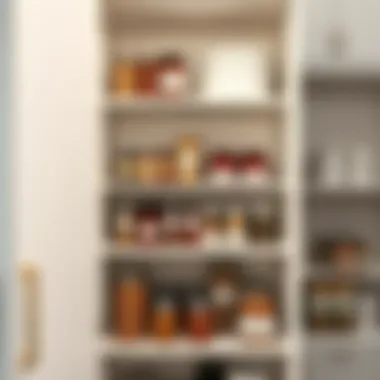

Intro
The kitchen often reflects the heart of a home—a place where meals are crafted, memories are shared, and daily rituals unfold. One pivotal aspect of this essential space is, without a doubt, the pantry. More specifically, the ability to efficiently organize a three-tier shelf pantry can transform not just how space is utilized but also how it feels overall. This article will explore the multifaceted nature of three-tier shelf pantries, shedding light on their design, functionality, and aesthetic attributes.
Gone are the days when garages and basements served as the sole storage areas for dry goods. Increasingly, homeowners are discovering innovative ways to maximize space while keeping kitchen essentials within arm’s reach, making the three-tier shelf pantry an attractive option. From the practical aspects such as accessibility and storage solutions, to the visual appeal of incorporating colors and textures, this guide aims to help you navigate the journey of creating a pantry that suits your style as well as your needs.
By delving into furniture design trends, practical tips for selection, and insights into how to blend utility with beauty, homeowners, designers, and decorators will find not just answers, but inspiration to elevate their kitchen spaces.
As we venture into this exploration, let’s ensure that the cornerstone of good pantry design is an understanding of how best to leverage its potential.
Furniture Design Trends
Trending Materials and Textures
When it comes to materials, variety is the spice of life. From natural woods that impart warmth, to sleek metal finishes that scream modernity, choosing the right material for your three-tier shelf pantry is crucial. White oak and maple are popular choices for creating a classic look, while bamboo has been gaining traction for eco-conscious homeowners due to its sustainability.
Texture is another element worth considering. Mixing smooth and textured surfaces can add depth to the pantry. For instance, perhaps you pair a rugged wire basket for potatoes with a smooth, polished shelf for spices. It creates an interplay that’s not just functional, but visually captivating, ensuring everything has its rightful place without sacrificing style.
"The right material can either complement a kitchen’s aesthetic or become a focal point in its own right.”
Color Palettes and Styles
Just like the layers of a well-prepared dish, the paint and finish on your pantry shelves need thoughtful compounding. Neutral tones such as beiges, grays, and whites typically promote serenity, keeping the feel grounded and spacious. However, bold colors—like deep greens or rich blues—can offer a striking contrast and create a dramatic appeal.
When selecting colors, also consider the overall kitchen theme. A rustic farmhouse might lend itself well to creamy whites and woods, whereas a minimalist kitchen could go for stark black and glossy finishes. Opting for pastel accents, such as light pinks or mint greens, can bring a playful element to the design that might just brighten your day.
Practical Tips for Furniture Selection
Assessing Space and Functionality
Before diving headfirst into the design, take a step back and consider the available space. A well-designed three-tier shelf pantry depends largely on the kitchen layout. Measure your space wisely; this can help in determining the size and configuration of shelves. An area that seems ample might not always be ideal for a long, wide unit. Instead, opt for vertical height if space is limited, as this utilizes the full potential of your pantry area.
Think about what you'll store. If it's an array of canned goods, spices, and baking supplies, a combination of closed and open shelves might suit the pantry best. Closed cabinets can keep dust at bay while showcasing frequently used items on open shelves can assist in quick access.
Balancing Aesthetics with Comfort
Beauty and functionality go hand in hand in a well-rounded pantry design. While it’s tempting to focus on the visual touches, remember comfort plays a role too. Ensure that shelves are easy to reach—no one wants to climb Mount Everest just to grab a bottle of chili sauce. Consider incorporating pull-out drawers or baskets for deeper shelves, allowing easier access while keeping a clean aesthetic.
The interplay between your pantry’s style and function should create a cohesive narrative—a space that feels welcoming while also serving its purpose. Add thoughtful decor elements like charming labels or decorative jars filled with ingredients to invite an engaging visual story every time you open the pantry door.
End
In a world where space is often at a premium, a three-tier shelf pantry serves as both a practical solution and a design statement. By attending to the trends in materials and color palettes, alongside thoughtful planning of functionality, you can create a pantry that is not only organized but also elevates the overall style of your kitchen. This blend of aesthetics and utility is what ultimately creates a space that every homeowner or designer will appreciate for years to come.
Intro to Three-Tier Shelf Pantries
In the fast-paced world we live in, the kitchen often becomes the heart of the home, a bustling hub where meals are prepared and memories are made. Within this space, the way we organize our ingredients and essentials plays a crucial role in not only functionality but also in how we feel when we step into the kitchen. This is where three-tier shelf pantries come into play. These innovative structures offer a blend of design and utility, revolutionizing how we approach food storage and access.
The three-tier shelf pantry is more than just an arrangement of shelves. It represents a smart blending of vertical space and thoughtful design. By incorporating vertical layers, it maximizes the use of limited space effectively. This feature is particularly valuable in modern kitchens, where every square inch matters, and the last thing anyone wants is to waste precious storage room.
Defining the Concept
A three-tier shelf pantry, in essence, is designed with three horizontal levels of shelves, allowing for a more natural organization of items ranging from canned goods to baking supplies. It's a practical solution that caters to various kitchen sizes and styles. You might find yourself wondering about the logistics of accessing items on higher shelves; hence, this pantry design often incorporates features like step stools or sliding baskets to ensure everything remains within arm's reach. This aspect is especially beneficial for busy households where efficiency is key.
Furthermore, these pantries come in a plethora of designs and finishes, allowing homeowners to choose one that complements their kitchen aesthetics. The potential for customization is vast, enabling you to create a pantry that not only functions smoothly but also adds a touch of elegance to your cooking space. Particular attention can be given to materials, colors, and even lighting within these pantries, enhancing overall appeal while maintaining organization.
Historical Evolution of Pantry Designs
When examining the three-tier shelf pantry, it's vital to appreciate how far pantry designs have come over the years. Traditionally, kitchens were equipped with standalone cupboards or shelves. These setups could often feel cramped, limiting one's ability to curate an organized cooking space. Over the decades, as kitchens evolved into more multifunctional areas, so did the designs of storage solutions, leading to the introduction of multi-tier structures.
Many would argue that the modern three-tier pantry draws its roots from the early 20th century, a time when home cooking began to thrive with the advent of household appliances and modern culinary practices. As food preservation methods improved, the need for efficient storage grew, pushing designers to innovate beyond the conventional cabinetry. Now, the three-tier shelf pantry represents not just a practical solution; it also reflects a shift toward open-concept living where visibility and accessibility are highly prioritized.
In today's kitchens, three-tier shelf pantries are lauded for their versatility. They can be found tucked into corners or boldly incorporated as central features, reflecting our evolving lifestyle and the importance we place on efficiency and aesthetics. This evolution symbolizes a greater emphasis on thoughtful design, one that not only aims for practicality but also enhances overall kitchen decor.
Benefits of a Three-Tier Shelf Pantry
Designing a kitchen involves more than just picking out the right cabinets and countertops. One of the often-overlooked elements that can truly transform your cooking space is the pantry. The three-tier shelf pantry offers a plethora of advantages that make it a must-have for homeowners, designers, and decorators alike. This section delves into the myriad benefits of implementing a three-tier system, integrating both functionality and visual allure to elevate your kitchen.
Maximizing Vertical Space
In many homes, kitchen space is at a premium, making efficient use of every square inch crucial. The three-tier shelf pantry excels in this regard. By stacking shelves vertically, you utilize upwards space that often goes to waste in traditional pantries.
- Increased Storage: Instead of bulky cabinets that only provide limited access, thin shelves can accommodate a wider variety of items. Whether it’s canned goods, snacks, or even small kitchen appliances, a three-tier design allows you to store more without feeling cramped.
- Effortless Visibility: With a well-structured layout, you can see exactly what you have at a glance. No more digging through cluttered shelves or pushing items around to figure out if you're out of that vital ingredient. Easy visibility not only saves time but also helps track expiration dates more effectively.
As people say, "Good things come in threes," and when it comes to pantry organization, implementing a three-tier system certainly rings true.
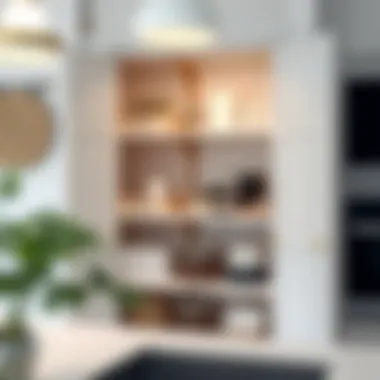

Enhanced Organization and Accessibility
A cluttered kitchen can lead to chaos—not just in the cooking process, but in an entire household’s efficiency. A three-tier shelf pantry inherently promotes organization, ensuring that everything has its designated spot.
- Categorization: By designating each tier for different categories, such as spices, snacks, and baking supplies, you can streamline your cooking workflow. You can even go a step further and adhere to a labeling system, ensuring that family members can easily find what they need.
- Accessible Height: No more stretching to the back of a deep cabinet. Three-tier shelving puts everything within arm's reach. The design allows for comfortable access to the items you frequently use, while less-used items can be stored higher up, reducing the risk of accidents or spills.
Ultimately, the organization provided by a three-tier shelf pantry can lead to a more pleasant cooking experience, turning meal prep from a chore into an enjoyable task.
Aesthetic Appeal in Kitchen Design
Beyond functionality, a three-tier shelf pantry can enhance the overall aesthetic of your kitchen, contributing to a cohesive and stylish design. The possibility of playing with different materials, colors, and textures makes creative expression easy.
- Visual Brilliance: Whether you opt for sleek metal finishes or warm wooden shelves, the design can complement existing kitchen themes, from contemporary to rustic. Also, you can incorporate decorative items or colorful containers to turn a pantry into a visual centerpiece without overshadowing practicality.
- Open Concept Trend: As open-concept kitchens continue to rise in popularity, a three-tier shelf pantry fits perfectly into this layout. Being open and airy, it allows for better integration with living spaces, making guests feel welcomed rather than confined when they step into the heart of the home.
In summary, a well-designed three-tier shelf pantry doesn’t just meet storage needs; it enhances your kitchen’s aesthetics while offering an organized and accessible solution for everyday cooking.
"A well-organized pantry can turn a kitchen from functional chaos into a visual delight."
By acknowledging these benefits, homeowners and designers can harmoniously blend form with function, ultimately creating a kitchen that reflects personal style while meeting practical demands.
Designing Your Three-Tier Shelf Pantry
Designing a three-tier shelf pantry is not just about aesthetics; it’s about creating a functional space that meets the everyday needs of your kitchen. A well-thought-out pantry can transform your kitchen experiences, making it easier to find ingredients and minimize clutter. This section will cover various essential aspects, considerations, and benefits that come with designing your pantry effectively.
Choosing the Right Materials
Choosing the right materials for your pantry is crucial. The choice between wood and metal can drastically influence both the functionality and overall vibe of your kitchen storage.
Wood vs. Metal
When considering wood vs. metal, it’s worth noting each material's unique characteristics. Wood often brings warmth and an inviting feel to the kitchen, while metal can offer a more modern, industrial touch. Wood has the advantage of being lightweight and generally easier to work with, which might be a plus if you’re planning on building your shelves yourself. However, it can also be prone to warping or damage from moisture if not properly treated.
On the flip side, metal tends to be more durable and resistant to moisture and pests, making it a solid choice for long-term usage. It also fits into various design themes, from rustic to contemporary. However, metal shelves can be more challenging to install and often require additional reinforcement compared to wood.
Finishes and Textures
Finishes and textures play a pivotal role in the overall aesthetic and usability of your pantry. Whether you prefer a natural wood grain finish or a sleek metal texture, the choices you make here can tie your pantry seamlessly into the kitchen’s design.
A natural finish on wood can highlight the organic beauty of the material, giving a warm and earthy feel. Alternatively, textured metal finishes may add a layer of sophistication, appealing to modern design sensibilities. However, keep in mind that specific finishes can affect maintenance; a matte finish may hide fingerprints better than a glossy one, but it might also show scratches more easily. It’s essential to choose a finish that complements your lifestyle while enhancing the beauty of the shelving.
Size Considerations and Dimensions
Size and dimensions are key factors in designing a three-tier shelf pantry. Before diving into the design, measure your available space thoroughly. Each shelf tier should be high enough to accommodate various pantry items without squishing them together, allowing for easy access. Think about the tallest items you usually store; it often helps to build the shelves around their height. Additionally, allowing for some space above each tier can help to avoid clutter, so remember to plan ahead.
Layout Planning Techniques
Effective layout planning is essential for optimizing the functionality of your pantry. It might seem straightforward, but there are several facets to consider.
Functional Zones
Creating functional zones within your pantry can enhance the overall experience. By organizing categories such as snacks, canned goods, and baking supplies into specific areas, you make it easier to find what you need quickly. This zone-oriented approach reduces wasted time rummaging through clutter. Consider using baskets or containers to define these zones visually as well.
Flow and Accessibility
Flow and accessibility are about maximizing efficiency when moving through your pantry. Imagine reaching for that jar of sugar without knocking over a stack of cans; a thoughtful layout can prevent such mishaps. Group frequently used items at eye level while placing those you seldom access on the top shelves. This strategy not only simplifies food prep but also spruces up user experience, making your kitchen feel more inviting.
"A well-organized pantry is the key to a well-organized kitchen."
Ultimately, an effective pantry design balances thoughtful material choices, the right dimensions, and a layout that promotes easy access and flow. By incorporating these principles, you can turn your three-tier shelf pantry into a cornerstone of functionality and style in your kitchen.
Optimizing Functionality
When it comes to a three-tier shelf pantry, functionality is king. The way you organize your food items can significantly impact both your cooking efficiency and overall kitchen experience. A pantry that lacks organization can become an exercise in frustration, where time is wasted rummaging through cluttered shelves. Emphasizing functionality involves considering how individual items are categorized, how they are stored, and ongoing maintenance methods.
Categorization of Pantry Items
Staples
Staples are the backbone of any well-stocked pantry. These include essential items such as rice, pasta, canned goods, and spices. The primary aspect of incorporating staples is their versatility. They can form the basis of countless recipes, making them a smart choice for quick meal preparations. The key characteristic of staples is their long shelf life, which means they can be stored for extended periods without worry.
One unique feature of staples is their ability to stand alone in meals or complement fresh ingredients. For instance, rice can be paired with vegetables for a quick stir-fry or served with protein for a complete meal. While they are generally reliable, it's crucial to keep an eye on expiration dates and rotate them regularly to avoid waste. Their predictable usage makes them popular for maintaining an organized pantry, ensuring that essential items are always on hand.
Seasonal Goods
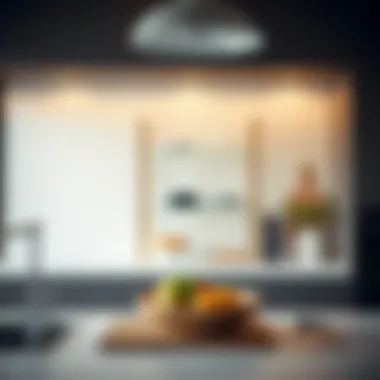
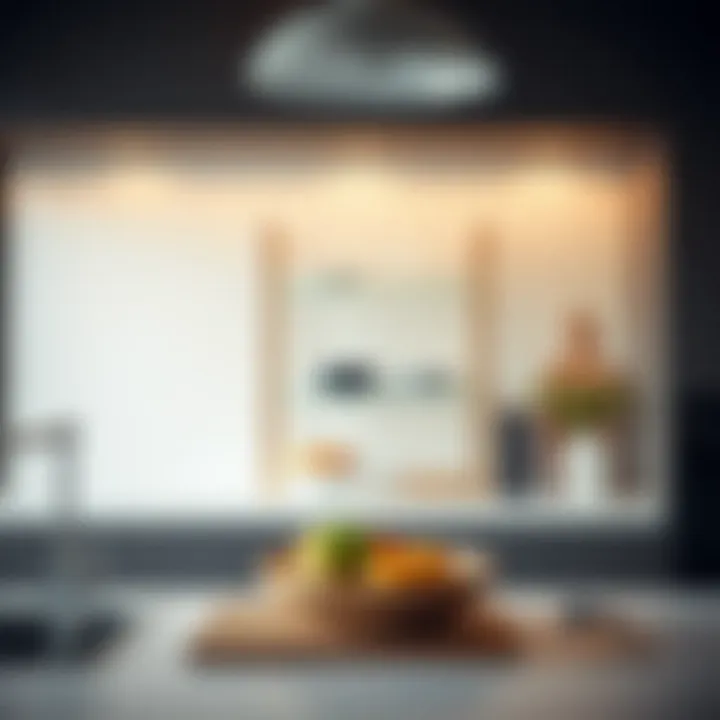
Seasonal goods reflect the ebb and flow of nature, changing throughout the year. They may include items such as pumpkin for fall recipes, fresh berries in summer, or cranberry sauce for the holidays. The key aspect of seasonal goods is their time-sensitive nature. They contribute to culinary creativity, pushing home cooks to experiment with varied ingredients and flavors that align with the seasons.
These goods are beneficial for several reasons, including freshness and enhanced flavor profiles that can elevate dishes. However, their unique feature is also a double-edged sword; if not managed properly, they can easily lead to overstocking or spoilage. Thus, being mindful of their availability and planning meals around them can help leverage their benefits while minimizing waste.
Utilizing Containers and Labels
Employing containers and labels is an effective strategy to keep everything neat and accessible. Decanting bulk items into labeled containers not only looks appealing but also makes it easier to track inventory. Clear containers provide a glimpse of what’s inside without rummaging, and labels help everyone in the household find ingredients quickly. Having a designated system can prevent unnecessary purchases and promote efficient meal planning.
Maintaining Organization Over Time
Cleaning Routines
Establishing regular cleaning routines is essential for maintaining a well-functioning pantry. Dust and crumbs can accumulate, not to mention expired items that sneak their way to the back of the shelves. A stable cleaning routine allows homeowners to refresh their spaces routinely. The characteristic of consistency in cleaning helps in keeping the pantry tidy and usable.
With a proper schedule, individuals can set aside time—say, once a month—to review expired goods, tidy the shelves, and reorganize how items are stored. The unique benefit of this habit is that it acts as a regular inventory check, ensuring that your pantry remains functional and aesthetically pleasing for everyday use without deep cleaning every now and then.
Inventory Management
Inventory management is the unsung hero of pantry upkeep. This process involves tracking what you have on hand and what needs to be replenished. A well-managed inventory can significantly enhance cooking efficiency, guaranteeing that ingredients are readily available. Regular review of pantry contents makes for an efficient restocking process, saving both time and money.
In essence, the benefit of having an organized inventory means less chance of duplicate items being purchased and a reduced risk of food waste. Utilizing apps or simple lists can lead to a more seamless cooking experience.
An organized pantry can transform cooking from a chore into a delightful journey, making every meal a reflection of your personal taste.
Incorporating Style into Your Pantry
When we think of pantries, the first thing that often comes to mind is functionality. But that's not all there is to it. Incorporating style into your pantry can transform it from a mere storage space into an integral part of your kitchen’s aesthetic. Style plays a vital role in creating a warm and inviting cooking environment. This section explores various elements that contribute to the overall look and feel of a three-tier shelf pantry.
Color Schemes and Accents
Color schemes are not just for the walls; they’re crucial for your pantry as well. Choosing the right colors can brighten up the space and make it more enjoyable to use. Consider hues that resonate with your kitchen’s overall theme. A soft cream or a muted gray can provide a neutral base that allows your pantry items to stand out. On the other hand, splashy colors like teal or burnt orange can add a burst of energy.
Additionally, accents can play a significant role in style. Think about adding vibrant dishes or colorful containers to complement the backdrop. You might find that a well-placed collection of vintage jars in green glass adds a charming touch while serving practical purposes.
Using a cohesive palette can link your pantry design with the rest of your kitchen, creating a seamless flow. Don’t shy away from playful patterns as well. If classic is what you're after, a simple stripe or checkerboard on containers can inject some character without overpowering the space.
Lighting Considerations
Lighting can make or break any space, including your pantry. A well-lit pantry not only showcases your carefully organized goods but also ensures that you find what you need without squinting like you’re in a dark cave. Consider using LED strip lights beneath the shelves to illuminate the items. This not only provides task lighting but also creates a warm atmosphere.
Overhead fixtures are another way to enhance the look of your pantry. A small chandelier or pendant light can introduce a touch of elegance. As an added bonus, consider dimmable options to adjust the brightness based on your needs and mood.
Natural light, if available, should never be overlooked. A window in the pantry is a delightful feature that can enhance your experience while you’re rummaging through jars and boxes.
Decorative Elements and Personal Touches
Decorative elements add that finishing touch that can truly personalize your pantry. Framed food-related art, inspirational quotes, or even a chalkboard for jotting down grocery lists can envelop the pantry in warmth. Consider placing a small potted herb or two on a shelf; not only do they serve a functional purpose, but they also bring a slice of nature indoors.
Don’t forget about the small details that reflect your personality. Customized labels for jars and containers can elevate the look while also making organization a breeze. Simple typography can embrace a modern look, while handwritten labels might express a rustic charm.
Remember, your pantry should reflect your style and make daily tasks more enjoyable. By weaving in color, light, and personal touches, you elevate its function beyond mere storage.
Incorporating style into your three-tier shelf pantry is about striking the right balance between aesthetic appeal and functionality. The goal is to create a pantry that enhances your kitchen experience while still meeting your needs. By thoughtfully considering these elements, you will create a pantry that's not only practical but also a pleasure to behold.
Three-Tier Shelf Pantry Innovations
In today's fast-paced world, a three-tier shelf pantry does more than just store food; it evolves into a multi-functional space within the kitchen. Embracing innovation is essential for maximizing efficiency, maintaining organization, and adding a touch of modernism to your home. Innovations in three-tier shelf pantries often revolve around technology and materials, showing how they can seamlessly blend practicality with style.
Smart Pantry Features
Tech Integration
When we speak about tech integration in pantries, we’re not just talking about the latest kitchen gadgets. This aspect involves the implementation of smart features that elevate the pantry experience. For instance, smart shelving systems can adjust their heights or configurations based on the size and shape of items stored. This adaptability is a game changer, especially when you consider the diverse range of containers and products homeowners often have.
A key characteristic of tech integration is connectivity. Many smart pantries can link to home networks, allowing users to track inventory via dedicated apps. Imagine getting notified when you're running low on essential items—no more last-minute grocery runs! However, while this technology is beneficial, it can also bring complexities, as not everyone is comfortable with advanced systems.
Unique features like digital organizational boards that sync with online recipes or meal planners can seamlessly integrate into daily cooking routines. The advantages? They enhance meal prep efficiency and streamline grocery shopping. On the downside, reliance on electricity and the need for periodic updates can be a nuisance for some. But at the end of the day, for those who embrace these advancements, tech integration can redefine functionality in the three-tier shelf pantry.
Climate Control Options
Climate control options represent another significant innovation in pantry design. This feature allows homeowners to maintain ideal conditions for specific foods—think wine storage or delicate spices that thrive in controlled environments. Essentially, climate control goes beyond the basic temperature regulation, incorporating humidity and light factors as well.
One key characteristic here is the ability to customize settings. For instance, if you’re storing chocolates or other perishables, you might prefer a cooler, more humid environment to prevent drying out. These systems are becoming increasingly sought after, especially in modern kitchens where food preservation is a top priority.
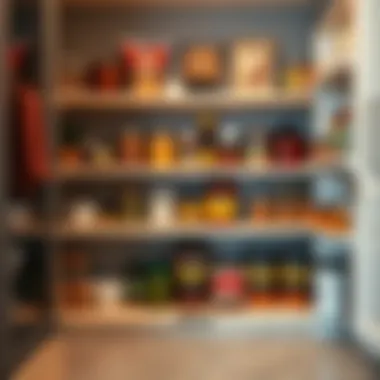
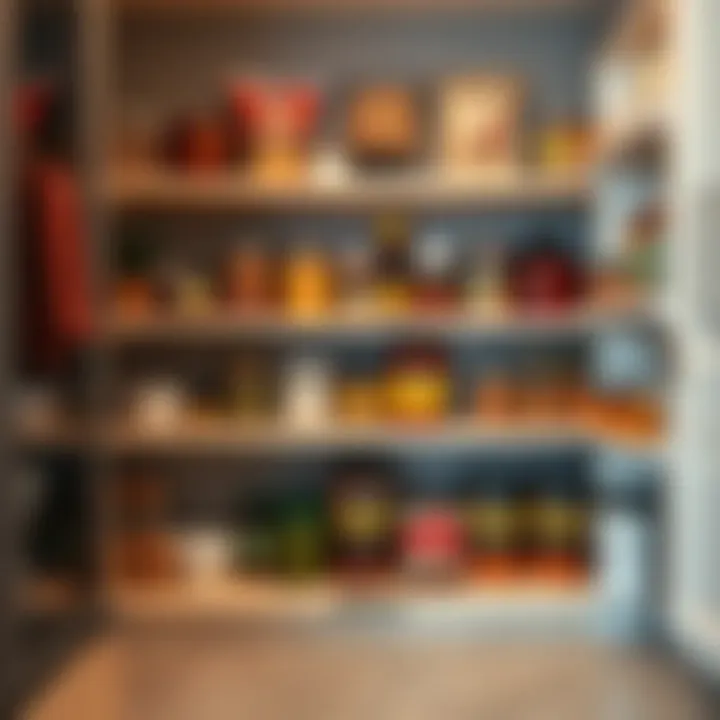
The unique benefit of climate control is that it preserves freshness, extends shelf life, and reduces waste, making it a popular choice for sustainability-conscious homeowners. However, such systems often come with higher costs and may require regular maintenance to ensure they function properly.
Sustainable Materials and Practices
Incorporating sustainable materials in the design of your three-tier shelf pantry not only represents an eco-friendly choice but also aligns with contemporary design trends. Utilizing materials like bamboo, reclaimed wood, or recycled metals not only adds visual appeal but speaks to a conscious lifestyle choice.
• Bamboo is durable and fast-growing, making it a superb option for shelves that are both functional and sustainable. • Reclaimed wood adds character and history, providing a unique touch to modern designs while minimizing depletion of natural resources. • Recycled metals contribute to a fresh, industrial style that fits right into contemporary kitchen aesthetics.
To further enhance sustainability, consider practices like minimizing waste during construction or opting for non-toxic finishes. Such practices not only support the health of the environment but can also improve indoor air quality.
In summary, three-tier shelf pantry innovations offer homeowners a blend of functionality, style, and sustainability. By integrating smart technology, climate control, and eco-friendly materials, these pantries evolve into sophisticated storage solutions that cater to the needs of modern living.
Common Mistakes to Avoid
When setting up a three-tier shelf pantry, it’s easy to get swept up in the excitement of organizing your kitchen space. However, a few common pitfalls can undermine even the best intentions. Being mindful to steer clear of these mistakes will not only save you time in the long run, but it will also ensure that your pantry is a functional and enjoyable component of your home. Let’s unpack some specific missteps and how to avoid them to create a truly effective pantry space.
Overloading Shelves
One of the most frequent errors homeowners make with their three-tier shelf pantry is overloading the shelves. It might seem tempting to utilize every inch of available space, cramming in every jar and box you can find. However, this approach can lead to various complications.
- Weight Considerations: Each shelf has a weight limit that’s often overlooked. By placing too many items on one shelf, you risk damaging the shelves themselves. If your shelves sag or become damaged, you’re left facing expensive repairs.
- Access Issues: When you overload shelves, you also create access problems. Items can easily get lost in the clutter, making it such a hassle just to find a bag of flour. This not only defeats the purpose of having an organized pantry but can also lead to wasted ingredients.
- Aesthetic Appeal: An overloaded pantry simply doesn’t look appealing. A cluttered appearance can discourage you from using it effectively, impacting your overall kitchen experience.
Instead, practice moderation and distribute the weight evenly. Periodically review the contents of your pantry and re-evaluate what you truly need on hand. Keeping things manageable will create a better flow and more harmonious crafting of meals.
Neglecting Accessibility
Another key mistake is neglecting accessibility. Life moves quickly, and when we make pantry items hard to reach or obscure, it can lead to frustration during cooking.
- Shelf Height Dynamics: A common tendency is to place both frequently used and seldom-used items on higher shelves, assuming that everything will be neatly tucked away. However, requiring a step stool to access staple items like cooking oils or spices disrupts your cooking rhythm.
- Container Choices: Using non-transparent containers can make it hard to see what’s inside, leading to unnecessary searching and rummaging. If your pantry clutters become inaccessible, you might end up buying duplicates of ingredients you can't find.
- Flow of Movement: Think about how often you reach for certain items. Items that you use on a regular basis should be front and center. Items that are infrequently used can go on the top shelf and be harder to reach. This arrangement not only maintains an attractive appearance but also boosts efficiency in your cooking processes.
To maximize accessibility, consider utilizing tiered organizers or clear containers that reveal the contents. Doing so ensures that you find what you need without playing hide and seek with your pantry items.
Effective organization is not just about how many items you can fit; it’s about how easily those items can be accessed and utilized.
By avoiding these common mistakes, you can foster an environment in your three-tier shelf pantry that is both practical and stylish. With a little forward thinking and planning, your pantry can be a beacon of organization, ready to support your culinary endeavors.
Maintaining Your Three-Tier Shelf Pantry
Maintaining your three-tier shelf pantry is crucial for prolonged functionality and visual appeal. While designing a pantry with thoughtful organization and aesthetic elements is vital, regular upkeep ensures these aspects don't fade over time. A well-maintained pantry improves not only efficiency in your kitchen but also uplifts the entire cooking experience. You want to find that Zen where everything is in its place, making your culinary adventures a breeze rather than a chore.
Regular Cleaning Schedule
Establishing a regular cleaning schedule is akin to breathing new life into your pantry. Dust, crumbs, and spills can sneak in and cause clutter or even attract unwanted pests. By committing to a consistent routine, you keep your pantry fresh.
- Frequency: Depending on usage, think about cleaning your pantry every month, or at the very least, seasonally.
- Process:
- Cleaning Products: Opt for natural cleaners when possible. A vinegar solution often does wonders without the harsh chemicals.
- Empty the Shelves: Start by taking everything off the shelves, allowing you to inspect each item closely.
- Wipe Down: Use a mixture of water and mild detergent to clean the shelves. Focus on corners and crevices where stains may have formed.
- Check Expiration Dates: This is an opportune moment to toss out expired goods and unpackaged items that have lost their freshness.
Keeping it clean not only helps in spotting what you have, but enhances the visual appeal of your pantry.
Inventory Review and Restocking
Conducting an inventory review is an essential practice that no pantry owner should overlook. It’s like meeting an old friend—you're reconnecting with what you have and determining if you're missing any key items.
- Set a Schedule: Aim for an inventory review every 2 to 3 months. This keeps your pantry up to snuff without it feeling overwhelming.
- Utilize a Checklist: Create a list of staples you use regularly, such as rice, beans, or pasta. By checking off items during your review, you’ll clearly see what needs replenishing.
- Restocking: When restocking, consider buying in bulk for essential items. It often saves money, but also means you're less likely to run low.
The twist here is to label your items clearly. Not only does this bring organization, but it also signifies at a glance what you have and what’s needed.
So, the next time you find yourself digging for a can of beans or a box of flour, remember that the effort you put into cleaning and inventory sorting pays off, making cooking much more enjoyable.
"An organized pantry reflects a joyful kitchen."
In summary, maintaining your three-tier shelf pantry through regular cleaning and consistent inventory checks enhances both the functional and aesthetic aspects of your culinary space. Remember, it’s not just about what’s inside, but how you keep it—because an efficient kitchen starts with a well-kept pantry.
Culmination: The Three-Tier Shelf Pantry as a Design Solution
The concept of a three-tier shelf pantry encapsulates more than just a storage solution; it represents a thoughtful approach to kitchen organization and style. As kitchens evolve into multi-functional spaces, the importance of maximizing utility while maintaining a visually appealing design becomes increasingly significant. A three-tier shelf pantry allows homeowners not merely to pile items into a closet but also to create an organized choreography of kitchen essentials.
Balancing functionality and aesthetics is essential. A well-structured pantry can simplify meal preparation and grocery management. You can easily access frequently used items without rummaging through clutter. This design promotes a smoother workflow in the kitchen, reducing the time spent searching for ingredients and allowing you to focus on the joy of cooking.
"A successful kitchen balances practicality with beauty; the three-tier shelf pantry exemplifies this principle."
Moreover, the visual impact of a pantry cannot be overstated. Opting for stylish materials and thoughtful layouts can elevate the overall ambiance of your kitchen. Choosing materials like natural wood or sleek metal not only enhances durability but also contributes to the kitchen's aesthetic theme, whether cozy farmhouse or modern minimalist. Colors and finishes can harmonize with other kitchen elements, weaving a story through the palette you choose.
Several considerations elevate the three-tier shelf pantry from a simple storage solution to a design statement. Dimensions, for instance, play a crucial role. Customizing the height and depth of the shelves ensures optimal accessibility and usability; nobody wants to struggle to reach for something tucked away in the farthest corner. Moreover, organizing the pantry into different zones can streamline food prep and inventory management.
Investing in a three-tier shelf pantry not only delivers on organization and accessibility but also enhances the emotional value of the space. A beautiful and functional pantry can inspire creativity in cooking. By crafting a kitchen environment that is both practical and pleasing to the eye, you provide a nurturing backdrop for family gatherings and culinary experimentation.
Ultimately, the three-tier shelf pantry serves as a bold, intelligent choice in modern design. It encompasses a philosophy that values harmony between usefulness and beauty, making it a compelling centerpiece in any kitchen. Craft your pantry with purpose and style; it may very well redefine the way you engage with your kitchen.



